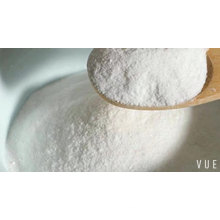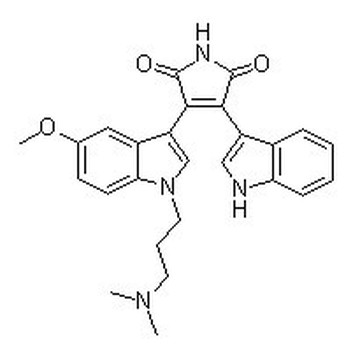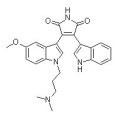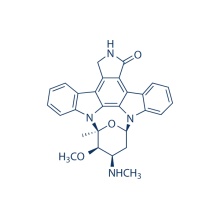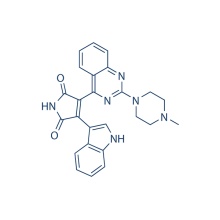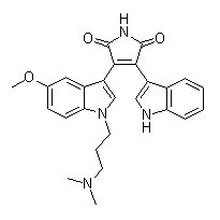.cp_wz tabla {borde superior: 1px sólido #ccc; borde izquierdo: 1px sólido #ccc; } .cp_wz table td {borde derecho: 1px sólido #ccc; borde inferior: 1px sólido #ccc; padding: 5px 0px 0px 5px;} .cp_wz table th {border-right: 1px solid #ccc; border-bottom: 1px solid #ccc; relleno: 5px 0px 0px 5px;} \ n Peso molecular: \ n 442.51 Go 6983 es un inhibidor de pan-PKC contra PKCα, PKCβ, PKCγ y PKCδ con IC50 de 7 nM, 7 nM, 6 nM y 10 nM, respectivamente; menos potente para PKCζ e inactivo para PKCμ. \ n Actividad biológica
|
Description
|
Go 6983 is a pan-PKC inhibitor against for PKCα, PKCβ, PKCγ and PKCδ with IC50 of 7 nM, 7 nM, 6 nM and 10 nM, respectively; less potent to PKCζ and inactive to PKCμ.
|
|
Targets
|
PKCγ [1]
|
PKCα [1]
|
PKCβ [1]
|
PKCδ [1]
|
PKCζ [1]
|
PKCμ [1]
|
|
IC50
|
6 nM
|
7 nM
|
7 nM
|
10 nM
|
60 nM
|
20 μM
|
|
In vitro
|
Go 6983 (300 μM) suppresses PKCμ auto-phosphorylation by 20% reduction in NIH3T3 transfected with PKCμ. In hearts reperfused with PMNs and Gö 6983 (100 nM), left ventricular developed pressure (LVDP) and the rate of LVDP recoveres to 89% and 74% of baseline values, respectively, significantly higher than PMNs alone. Gö 6983 (100 nM) significantly reduces PMNs adherence to the endothelium and infiltration into the myocardium compared with Ischemia followed by reperfusion (I/R)+ PMN hearts, and significantly inhibits superoxide release from PMNs by 90%. Gö 6983 attenuates post-I/R cardiac contractile dysfunction in the presence of PMNs, which may be related in part to decreased superoxide production. Gö 6983 significantly inhibits antigen-induced superoxide release from leukocytes of patients previously sensitized to tree pollen. Go 6983 inhibited intracellular Ca(2+) accumulation in human vascular tissue, suggesting a mechanism for its vasodilator properties. Go-6983 (1 μM) combined with Ro-31-8425 (390 nM) slightly inhibits Angiotensin II–induced PLD2 activity in PGSMCs. Go 6983 is isoform-specific PKC inhibitor that target the ATP binding site. Go 6983 inhibits ΔPfPKB activity with an IC50 of 1 μM. In Go 6983 (5 μM)-treated cells, the number of rings in the following cycle is markedly less compared with the control cultures. Go 6983 (5 μM) treatment results in an almost 60% decrease in formation of new rings in P. falciparum cultures.
|
|
In vivo
|
|
|
Features
|
|
Protocolo (solo como referencia) Ensayo de quinasa: [1]
|
Binding assay
|
Phosphorylation reactions are carried out in a total volume of 100 μL, containing buffer C (50 mM Tris-HC1, pH 7.5, 10 mM β-mercaptoethanol), 4 mM MgCl2, 10 μg PS, 100 nM TPA, 5 μL of a Sf158 cell extract as a source of recombinant PKCμ or of Sf9 cell extracts as a source of other recombinant PKC isoenzymes, 10 μg of syntide 2 as substrate, and 35 μM ATP containing 1 μCi [γ-32P]ATP. In some experiments PS and TPA are omitted or various inhibitors at concentrations indicated in the text are added. After incubation for 10 min at 30℃, the reaction is terminated by transferring 50 μL of the assay mixture onto a 20 mm square piece of phosphocellulose paper, which is washed 3 times in deionized water and twice in acetone. The radioactivity on each paper is determined by liquid scintillation counting.
|
Conversión de diferentes modelos de animales basados en BSA (valor basado en datos del Borrador de Directrices de la FDA)
|
Species
|
Baboon
|
Dog
|
Monkey
|
Rabbit
|
Guinea pig
|
Rat
|
Hamster
|
Mouse
|
|
Weight (kg)
|
12
|
10
|
3
|
1.8
|
0.4
|
0.15
|
0.08
|
0.02
|
|
Body Surface Area (m2)
|
0.6
|
0.5
|
0.24
|
0.15
|
0.05
|
0.025
|
0.02
|
0.007
|
|
Km factor
|
20
|
20
|
12
|
12
|
8
|
6
|
5
|
3
|
|
Animal A (mg/kg) = Animal B (mg/kg) multiplied by
|
Animal B Km
|
|
Animal A Km
|
Por ejemplo, para modificar la dosis de resveratrol utilizada para un ratón (22,4 mg / kg) a una dosis basada en el BSA para una rata, multiplique 22,4 mg / kg por el factor Km para un ratón y luego divida por el factor Km para una rata. Este cálculo da como resultado una dosis equivalente para ratas de resveratrol de 11,2 mg / kg.
|
Rat dose (mg/kg) = mouse dose (22.4 mg/kg) ×
|
mouse Km(3)
|
= 11.2 mg/kg
|
|
rat Km(6)
|
Información química
|
Molecular Weight (MW)
|
442.51
|
|
Formula
|
C26H26N4O3
|
|
CAS No.
|
133053-19-7
|
|
Storage
|
3 years -20℃Powder
|
|
6 months-80℃in solvent (DMSO, water, etc.)
|
|
Synonyms
|
GOE 6983
|
|
Solubility (25°C) *
|
In vitro
|
DMSO
|
59 mg/mL
(133.33 mM)
|
|
Water
|
<1 mg/mL
(
|
|
Ethanol
|
<1 mg/mL
(
|
|
In vivo
|
30% PEG400/0.5% Tween80/5% propylene glycol
|
30 mg/mL
|
* <1 mg/ml means slightly soluble or insoluble.
* Please note that Selleck tests the solubility of all compounds in-house, and the actual solubility may differ slightly from published values. This is normal and is due to slight batch-to-batch variations.
|
|
Chemical Name
|
1H-Pyrrole-2,5-dione, 3-[1-[3-(dimethylamino)propyl]-5-methoxy-1H-indol-3-yl]-4-(1H-indol-3-yl)-
|
Calculadora de molaridad Calculadora de dilución Calculadora de peso molecular Área de investigación Citas de productos (3) Los cilios primarios en las células madre y los progenitores neurales están regulados por la esfingomielinasa neutra 2 y la ceramida. [He Q Mol Biol Cell 2014; 25 (11): 1715-29] PubMed: 24694597 La translocación nuclear de la proteína CITED1 que interactúa con CBP / p300 inducida por la hormona paratiroidea requiere fosforilación de serina en la posición 79 en su dominio 63-84 [Lin Z, et al. Cell Signal 2014; 26 (11): 2436-2445] PubMed: 25049079 WNT5A, un regulador de la progresión del cáncer, promueve la migración y la invasión de las células del carcinoma escamoso oral. [Prgomet Z, et al. J Oral Pathol Med 2014; 10.1111 / jop.12292] PubMed: 25459554 Clientes que compraron este artículo también compraron Y-27632 2HCl Y-27632 2HCl es un inhibidor selectivo de ROCK1 (p160ROCK) con Ki de 140 nM, presenta una selectividad> 200 veces sobre otras quinasas, incluyendo PKC, proteína quinasa dependiente de cAMP, MLCK y PAK. Sotrastaurin Sotrastaurin es un inhibidor de pan-PKC potente y selectivo, principalmente para PKCθ con Ki de 0,22 nM; inactivo para PKCζ. Fase 2. Características: A diferencia de los inhibidores anteriores de PKC, Sotrastaurin no mejora la apoptosis de blastos de células T murinas en un modelo de muerte celular inducida por activación. SP600125 SP600125 es un inhibidor de JNK de amplio espectro para JNK1, JNK2 y JNK3 con IC50 de 40 nM, 40 nM y 90 nM, respectivamente; Selectividad 10 veces mayor contra MKK4, selectividad 25 veces mayor contra MKK3, MKK6, PKB y PKCα, y selectividad 100 veces mayor contra ERK2, p38, Chk1, EGFR, etc. H 89 2HCl H 89 2HCl es un potente inhibidor de PKA con Ki de 48 nM, 10 veces más selectivo para PKA que para PKG, más de 500 veces más selectivo que PKC, MLCK, calmodulina quinasa II y caseína quinasa I / II. Ibrutinib (PCI-32765) Ibrutinib es un inhibidor potente y altamente selectivo de la tirosina quinasa de Brutons (Btk) con IC50 de 0.5 nM, moderadamente potente para Bmx, CSK, FGR, BRK, HCK, menos potente para EGFR, Sí, ErbB2, JAK3, etc. CHIR-99021 (CT99021) HCl CHIR-99021 (CT99021) HCl es clorhidrato de CHIR-99021, que es un inhibidor de GSK-3α / β con IC50 de 10 nM / 6,7 nM; capacidad para distinguir entre GSK-3 y sus homólogos más cercanos Cdc2 y ERK2. Soporte técnico y preguntas frecuentes Las respuestas a las preguntas que pueda tener se pueden encontrar en las instrucciones de manejo del inhibidor. Los temas incluyen cómo preparar soluciones madre, cómo almacenar inhibidores y cuestiones que requieren atención especial para ensayos basados en células y experimentos con animales.
Grupos de Producto : Señalización citoesquelética > Inhibidor de PKC
